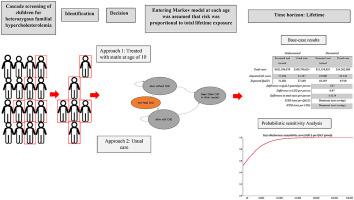当前位置:
X-MOL 学术
›
Atherosclerosis
›
论文详情
Our official English website, www.x-mol.net, welcomes your feedback! (Note: you will need to create a separate account there.)
Health economic evaluation of screening and treating children with familial hypercholesterolemia early in life: Many happy returns on investment?
Atherosclerosis ( IF 5.3 ) Pub Date : 2020-07-01 , DOI: 10.1016/j.atherosclerosis.2020.05.007 Zanfina Ademi 1 , Richard Norman 2 , Jing Pang 3 , Danny Liew 1 , Sophia Zoungas 1 , Eric Sijbrands 4 , Brian A Ference 5 , Albert Wiegman 6 , Gerald F Watts 3
Atherosclerosis ( IF 5.3 ) Pub Date : 2020-07-01 , DOI: 10.1016/j.atherosclerosis.2020.05.007 Zanfina Ademi 1 , Richard Norman 2 , Jing Pang 3 , Danny Liew 1 , Sophia Zoungas 1 , Eric Sijbrands 4 , Brian A Ference 5 , Albert Wiegman 6 , Gerald F Watts 3
Affiliation

|
BACKGROUND AND AIMS
There are no studies that have specifically investigated the cost-effectiveness of cascade screening of children for heterozygous familial hypercholesterolemia (FH) and treatment of affected individuals with statins to prevent coronary heart disease (CHD). This study explores the cost-effectiveness of this strategy from the perspective of the Australian public healthcare system. METHODS
A lifetime Markov model with four health states (Alive without CHD, Alive with CHD, Dead from fatal CHD, and Dead from other causes) was developed to simulate the progression of ten-year-old children screened for FH and treated immediately with statins if found to have FH. The underlying prevalence of FH in this target population was assumed to be 56.8%, and the sensitivity and specificity of testing were 100%. The comparator was usual care, which assumed that subjects started statins spontaneously at a later point or when they experienced a cardiovascular event. The effect of reducing low-density lipoprotein cholesterol (LDL-C) on the risk of a first event at each age assumed that risk was proportional to total lifetime exposure and was implemented using Mendelian randomisation analysis data. Cost and other outcome data were sourced from published sources. Outcome of interests were costs in Australian dollars (AUD), life years gained (LYG) and quality-adjusted life years (QALYs) gained, as well as incremental cost-effectiveness ratios (ICERs) of costs per LYG and per QALY gained. All future costs and outcomes were discounted by 5% annually. RESULTS
Undiscounted results showed that compared with usual care, cascade screening of ten year-old children for FH and initiation of treatment of affected individuals saved 7.77 LYG and 7.53 QALYs per person over a lifetime. With 5% annual discounting, there were 0.97 LYG and 1.07 QALYs gained per person, at net reduction cost of -$1134. The cascade screening of ten-year-old children for FH and initiation of treatment compared to usual case was a cost saving approach. In 51.2% of iterations, screening and initiation with statin were cost saving and in 48.8% of iterations were cost-effective. In most of the one-way sensitivity and scenario analyses, the ICER stayed within the accepted Australian threshold. CONCLUSIONS
Compared to usual care, cascade screening of ten-year-old children for FH and treating affected individuals are likely to be cost saving.
中文翻译:

早期筛查和治疗家族性高胆固醇血症儿童的健康经济学评价:投资回报丰厚?
背景和目的 尚无研究专门调查对杂合子家族性高胆固醇血症 (FH) 儿童进行级联筛查的成本效益以及使用他汀类药物治疗受累个体以预防冠心病 (CHD) 的成本效益。本研究从澳大利亚公共医疗保健系统的角度探讨了该策略的成本效益。方法 开发了具有四种健康状态(没有 CHD 的活着、患有 CHD 的活着、死于致命性 CHD 和死于其他原因)的终身马尔可夫模型来模拟接受 FH 筛查并立即接受他汀类药物治疗的 10 岁儿童的进展如果发现有 FH。假设该目标人群中 FH 的潜在患病率为 56.8%,测试的敏感性和特异性为 100%。比较器是通常的护理,假设受试者在稍后或当他们经历心血管事件时自发地开始使用他汀类药物。降低低密度脂蛋白胆固醇 (LDL-C) 对每个年龄首次事件风险的影响假定风险与终生总暴露成正比,并使用孟德尔随机化分析数据实施。成本和其他结果数据来自已发表的来源。利息结果是以澳元 (AUD)、获得的生命年 (LYG) 和质量调整生命年 (QALY) 为单位的成本,以及每个 LYG 和每个 QALY 成本的增量成本效益比 (ICER)。所有未来的成本和结果每年都打折 5%。结果 未贴现结果显示,与常规护理相比,对 10 岁儿童进行 FH 级联筛查并开始对受影响个体进行治疗,每人一生可节省 7.77 LYG 和 7.53 QALY。每年折扣为 5%,每人获得 0.97 LYG 和 1.07 QALY,净减少成本为 - 1134 美元。与普通病例相比,对 10 岁儿童进行 FH 级联筛查和开始治疗是一种节省成本的方法。在 51.2% 的迭代中,筛选和开始使用他汀类药物可以节省成本,而在 48.8% 的迭代中具有成本效益。在大多数单向敏感性和情景分析中,ICER 保持在澳大利亚公认的阈值内。结论 与常规护理相比,对 10 岁儿童进行 FH 级联筛查和治疗受影响的个体可能会节省成本。每人一生中 53 个 QALY。每年折扣为 5%,每人获得 0.97 LYG 和 1.07 QALY,净减少成本为 - 1134 美元。与普通病例相比,对 10 岁儿童进行 FH 级联筛查和开始治疗是一种节省成本的方法。在 51.2% 的迭代中,筛选和开始使用他汀类药物可以节省成本,而在 48.8% 的迭代中具有成本效益。在大多数单向敏感性和情景分析中,ICER 保持在澳大利亚公认的阈值内。结论 与常规护理相比,对 10 岁儿童进行 FH 级联筛查和治疗受影响的个体可能会节省成本。每人一生中 53 个 QALY。每年折扣为 5%,每人获得 0.97 LYG 和 1.07 QALY,净减少成本为 - 1134 美元。与普通病例相比,对 10 岁儿童进行 FH 级联筛查并开始治疗是一种节省成本的方法。在 51.2% 的迭代中,筛选和开始使用他汀类药物可以节省成本,而在 48.8% 的迭代中具有成本效益。在大多数单向敏感性和情景分析中,ICER 保持在澳大利亚公认的阈值内。结论 与常规护理相比,对 10 岁儿童进行 FH 级联筛查和治疗受影响的个体可能会节省成本。与普通病例相比,对 10 岁儿童进行 FH 级联筛查并开始治疗是一种节省成本的方法。在 51.2% 的迭代中,筛选和开始使用他汀类药物可以节省成本,而在 48.8% 的迭代中具有成本效益。在大多数单向敏感性和情景分析中,ICER 保持在澳大利亚公认的阈值内。结论 与常规护理相比,对 10 岁儿童进行 FH 级联筛查和治疗受影响的个体可能会节省成本。与普通病例相比,对 10 岁儿童进行 FH 级联筛查并开始治疗是一种节省成本的方法。在 51.2% 的迭代中,筛选和开始使用他汀类药物可以节省成本,而在 48.8% 的迭代中具有成本效益。在大多数单向敏感性和情景分析中,ICER 保持在澳大利亚公认的阈值内。结论 与常规护理相比,对 10 岁儿童进行 FH 级联筛查和治疗受影响的个体可能会节省成本。
更新日期:2020-07-01
中文翻译:

早期筛查和治疗家族性高胆固醇血症儿童的健康经济学评价:投资回报丰厚?
背景和目的 尚无研究专门调查对杂合子家族性高胆固醇血症 (FH) 儿童进行级联筛查的成本效益以及使用他汀类药物治疗受累个体以预防冠心病 (CHD) 的成本效益。本研究从澳大利亚公共医疗保健系统的角度探讨了该策略的成本效益。方法 开发了具有四种健康状态(没有 CHD 的活着、患有 CHD 的活着、死于致命性 CHD 和死于其他原因)的终身马尔可夫模型来模拟接受 FH 筛查并立即接受他汀类药物治疗的 10 岁儿童的进展如果发现有 FH。假设该目标人群中 FH 的潜在患病率为 56.8%,测试的敏感性和特异性为 100%。比较器是通常的护理,假设受试者在稍后或当他们经历心血管事件时自发地开始使用他汀类药物。降低低密度脂蛋白胆固醇 (LDL-C) 对每个年龄首次事件风险的影响假定风险与终生总暴露成正比,并使用孟德尔随机化分析数据实施。成本和其他结果数据来自已发表的来源。利息结果是以澳元 (AUD)、获得的生命年 (LYG) 和质量调整生命年 (QALY) 为单位的成本,以及每个 LYG 和每个 QALY 成本的增量成本效益比 (ICER)。所有未来的成本和结果每年都打折 5%。结果 未贴现结果显示,与常规护理相比,对 10 岁儿童进行 FH 级联筛查并开始对受影响个体进行治疗,每人一生可节省 7.77 LYG 和 7.53 QALY。每年折扣为 5%,每人获得 0.97 LYG 和 1.07 QALY,净减少成本为 - 1134 美元。与普通病例相比,对 10 岁儿童进行 FH 级联筛查和开始治疗是一种节省成本的方法。在 51.2% 的迭代中,筛选和开始使用他汀类药物可以节省成本,而在 48.8% 的迭代中具有成本效益。在大多数单向敏感性和情景分析中,ICER 保持在澳大利亚公认的阈值内。结论 与常规护理相比,对 10 岁儿童进行 FH 级联筛查和治疗受影响的个体可能会节省成本。每人一生中 53 个 QALY。每年折扣为 5%,每人获得 0.97 LYG 和 1.07 QALY,净减少成本为 - 1134 美元。与普通病例相比,对 10 岁儿童进行 FH 级联筛查和开始治疗是一种节省成本的方法。在 51.2% 的迭代中,筛选和开始使用他汀类药物可以节省成本,而在 48.8% 的迭代中具有成本效益。在大多数单向敏感性和情景分析中,ICER 保持在澳大利亚公认的阈值内。结论 与常规护理相比,对 10 岁儿童进行 FH 级联筛查和治疗受影响的个体可能会节省成本。每人一生中 53 个 QALY。每年折扣为 5%,每人获得 0.97 LYG 和 1.07 QALY,净减少成本为 - 1134 美元。与普通病例相比,对 10 岁儿童进行 FH 级联筛查并开始治疗是一种节省成本的方法。在 51.2% 的迭代中,筛选和开始使用他汀类药物可以节省成本,而在 48.8% 的迭代中具有成本效益。在大多数单向敏感性和情景分析中,ICER 保持在澳大利亚公认的阈值内。结论 与常规护理相比,对 10 岁儿童进行 FH 级联筛查和治疗受影响的个体可能会节省成本。与普通病例相比,对 10 岁儿童进行 FH 级联筛查并开始治疗是一种节省成本的方法。在 51.2% 的迭代中,筛选和开始使用他汀类药物可以节省成本,而在 48.8% 的迭代中具有成本效益。在大多数单向敏感性和情景分析中,ICER 保持在澳大利亚公认的阈值内。结论 与常规护理相比,对 10 岁儿童进行 FH 级联筛查和治疗受影响的个体可能会节省成本。与普通病例相比,对 10 岁儿童进行 FH 级联筛查并开始治疗是一种节省成本的方法。在 51.2% 的迭代中,筛选和开始使用他汀类药物可以节省成本,而在 48.8% 的迭代中具有成本效益。在大多数单向敏感性和情景分析中,ICER 保持在澳大利亚公认的阈值内。结论 与常规护理相比,对 10 岁儿童进行 FH 级联筛查和治疗受影响的个体可能会节省成本。


























 京公网安备 11010802027423号
京公网安备 11010802027423号